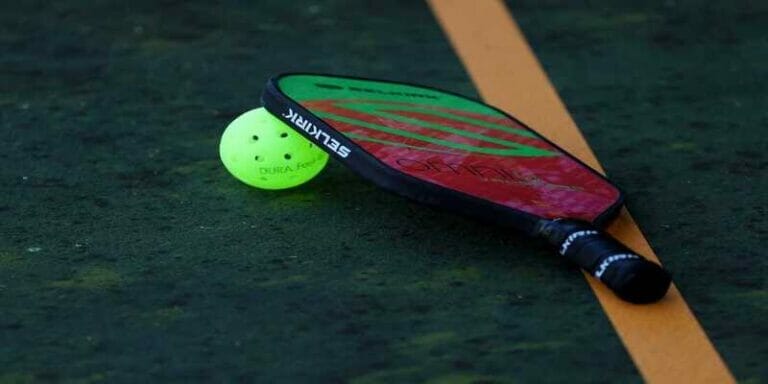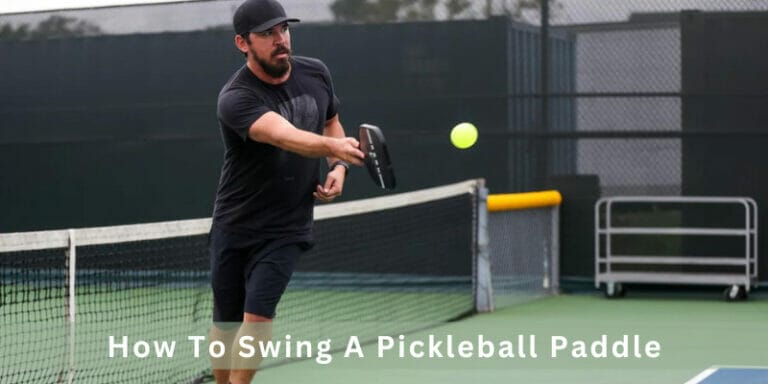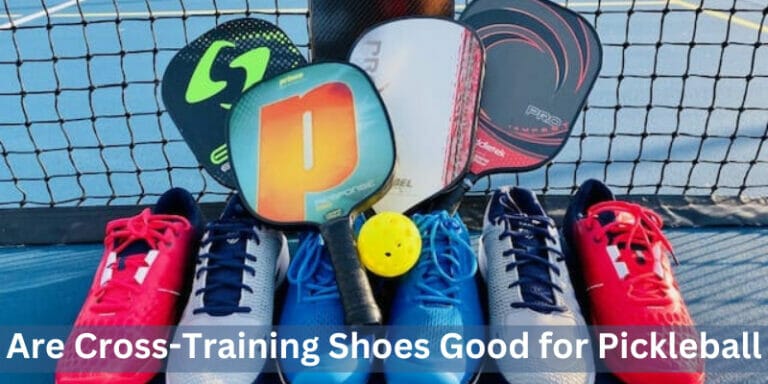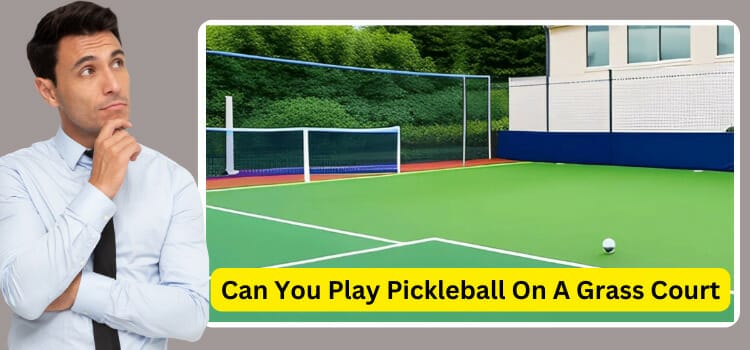How To Make A Pickleball Paddle At Home
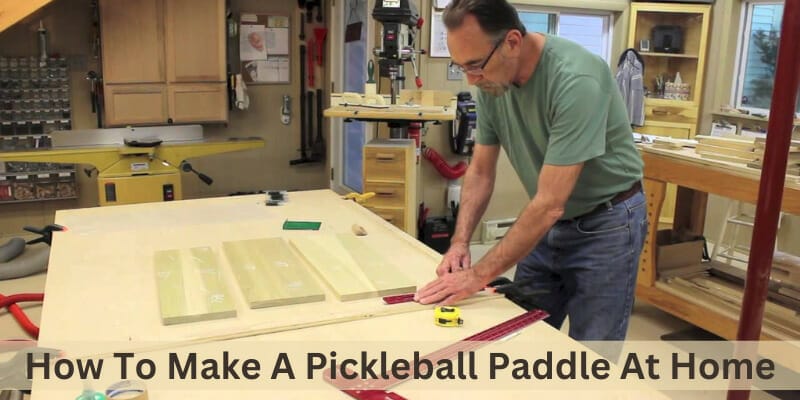
Transform your pickleball game with a homemade paddle customized to your playing style and preferences – it’s easier than you think!
To make a pickleball paddle at home, cut polymer into shape, sand it smooth, and attach the handle and grip. Basic woodworking tools and materials like glue, sandpaper, electric cutter, etc. are required. Personalize the design to fit your playing style and preferences.
How To Make A Pickleball Paddle At Home Comprehensive Guide
In this article, I am going to share a complete step-by-step guide about how to make a pickleball paddle at home.
Without any delay, let’s get into it!
Materials Need To Make a Pickleball Paddle at Home
The following are the things that you will need in order to make a paddle at your home:
- Polymer sheet/ Wood sheet
- Paddle
- Edge Guard
- Overgrip
- Glue
- Electric cutter
- Plastic or rubber trim
- Handle cap
- Thin wood sheet
- Double sticky tape
- Gloves
- marker
- Black spray paint
- Black metallic spray paint
- Table
Step By Step Guide
The following are the steps that you need to follow to make a customized paddle at your home.
1. Take a paddle and polymer sheet
Choosing a paddle and a polymer sheet is the first step in creating a custom pickleball paddle.
Selecting a paddle that you like will ensure that the finished product meets your needs and preferences (you can take a wood sheet also and follow the same procedure).
This step is crucial in creating a custom pickleball paddle. Choosing a paddle that you like and are comfortable playing with will determine the size, shape, weight, and feel of the finished product.
The polymer sheet you choose should be a durable and sturdy material that can withstand the rigors of gameplay. It is essential to choose a high-quality polymer sheet for your custom paddle to last long.
Overall, this step sets the foundation for the rest of the process and ensures that you have a high-quality base to work with, making it crucial to the success of creating a custom pickleball paddle.
2. Draw an outline around the paddle
Drawing an outline with the marker around the paddle will provide a guide for cutting the polymer sheet into the same shape as the paddle.
This step is important to ensure that the custom paddle fits the standard size and shape of a pickleball paddle.
One helpful tip is to place the paddle on top of the polymer sheet and use a light touch with your marker to trace around it.
Be sure to hold the paddle steady to avoid any wobbling or shifting during the tracing process.
3. Cut the template and polymer sheet
This step is crucial step in creating a custom pickleball paddle. It involves cutting out the template and polymer sheet to create the desired shape and size of the paddle.
To do this, you need to place the template onto the polymer sheet and carefully trace and cut along the lines.
Precise cutting and attention to detail are important to ensure that the final product is symmetrical and comfortable to hold.
With a well-cut template and polymer sheet, you can create a high-quality custom pickleball paddle that meets your needs and preferences.
4. Remove/Trim the extra edges
Trimming away extra edges will ensure that the paddle fits snugly in the player’s hand and reduces the risk of injury. It also creates a sleek and professional appearance.
This step involves removing excess material from the paddle and polymer sheet cut out in the previous step.
This is important for ensuring the paddle fits comfortably in the player’s hand without any rough or jagged edges.
Trimming the edges also creates a more professional-looking finish, which is important for tournaments or competitions.
This step may seem like a minor detail in the process, but it plays a crucial role in ensuring the paddle is comfortable, safe, and visually appealing.
5. Make the paddle edges smooth/ smooth edges with a sander/ sandpaper
Smoothing out the edges of the polymer sheet and the paddle using a sander or sandpaper will create a comfortable and non-slip surface for gripping.
This will help players maintain a secure hold on the paddle, reducing the risk of injury and improving overall performance.
It’s essential to sand the edges evenly to ensure that the paddle is symmetrical and comfortable to hold. Fine-grit sandpaper or sander should be used to avoid removing too much material.
Overall, this step is also very crucial for creating a custom pickleball paddle that is safe, comfortable, and enhances the player’s performance on the court.
6. Cut thin hardwood sheet pieces for the handle
For the handle, cut a thin hardwood sheet into 4 pieces of equal size with the help of a woodcutter according to the size of the handle.
The width and length of the pieces should be equal to the handle’s width and length.
Now combine two pieces together with double sticky tape to make it one and in the same way combine the other two pieces together.
After combining the two pieces, scrape off the sharp edges so we get smooth edges that will not damage our hands.
Align the pieces with the table edge and run the electric sander over the edges of the pieces. The electric sander will make the edges smoother.
Smooth all four edges with an electric sander to get rid of any uneven surfaces/ edges and to make the piece’s edges a bit rounded in shape.
Sharp edges hit badly in the hand affecting the smooth movement of the paddle in your hand. Also, cut out the corners with the cutter as shown in the figure given below.
Now cut out the double sticky tape of your piece size. Apply sticky tape on one side of the piece.
Remove the plastic wrap from the tape and paste it on the paddle handle. Follow the same procedure for the other side.
7. Check the circumference of the handle
The circumference of the handle should be around 4 inches, which is the standard size for most pickleball paddles.
To check the circumference, you can use a tape measure or a piece of string to wrap around the handle.
Make sure to measure at the widest point of the handle to ensure an accurate measurement.
If the circumference is not around 4 inches, adjustments can be made by adding or removing material from the handle or the wooden sheet.
It is important to take the time to ensure that the handle circumference is just right, as a comfortable and secure grip is key to success in pickleball.
8. Apply plastic/ rubber pieces on handle both sides
Take two strips of Handel’s length and apply double sticky tape on one side of each strip.
Apply the strips on both sides of the handle for covering the naked sides of the handle.
Cut the plastic strips a half-inch shorter than the paddle’s length. Make sure you leave half-inch of the space around the paddle shoulder because later you have to apply a grip around the handle.
Now apply electrical tape all around the paddle handle in the spiral form to secure the strips from falling off.
9. Apply handle cap
Apply some glue inside the handle cap and on the bottom of the handle as well. Apply the cap on the bottom of the handle.
After applying the cap on the handle, hit the paddle vertically on the ground until it get fixed to the handle. The glue will keep the cap stick to the handle.
Make sure you apply the appropriate amount of glue inside the cap because if you apply less glue, it will not let the cap stick properly and if you apply extra glue, it will come out from the cap.
Now clean the surface of the paddle from both sides with spirit. Once you are done cleaning your paddle, wrap a layer of the plastic sheet around the handle from the bottom to the shoulder of the paddle.
10. Paint the paddle
Now it’s time to paint the paddle. Hold the paddle in your non-dominant hand and black spray paint in the dominant hand.
Maintain a reasonable distance between the paddle and spray bottle and start spraying.
Basically, you have to apply three thin layers of black spray paint on the paddle’s face. Apply one thin layer of paint and dry it out with a dryer.
Apply the second layer of paint and dry it and in the same way apply the third layer and dry it. Make sure you dry out your paddle with the dryer after every layer.
In the end, apply a thin layer of black metallic spray paint to give it a smooth and metallic finish and dry it out with the dryer.
Now before going onto the next step, leave your paddle for at least 20 to 25 minutes for drying.
11. Measure paddle weight
Before attaching an edge guard to the paddle, measure the weight of the paddle. For checking, put
your paddle, edge guard, and grip on the weighing scale/machine.
- If you want a lightweight paddle then your paddle weight should lie between the 7 to 7.6-ounce range.
- If you want a midweight paddle then your paddle weight should lie between 7.6 and the 8.2-ounce range.
- And if you want a heavyweight paddle then your paddle weight should lie between the 8.2 to the 8.5-ounce range.
Your paddle’s maximum weight should be around 8.4 to 8.5 ounces. Make sure your paddle weight doesn’t exceed 8.5-ounce weight.
12. Prepare the edge guard
Before doing anything further, clean up the edge guard from the inside with the cloth dipped in spirit and dry it with a dryer.
Now apply double sticky tape on both sides of the edge guard and leave the center empty as shown in the image given below.
Remove the plastic from the double sticky tape and heat it with the dryer. Keep the edge guard aside and apply some glue on the edges of the paddle.
After applying glue, carefully attach one end of the edge guard on the paddle shoulder. Keep applying until the other end of the edge guard reaches the second shoulder of the paddle.
While applying make sure you are fixing the edge guard nicely onto the edges of the paddle. If the edge guard is exceeding the paddle shoulder then cut it and keep it to the paddle’s shoulder.
Make sure the edge guard is tight all around the edges of the paddle. Now secure the edge guard both ends with an electrical tape by wrapping a one or two loops so the edge guard would not open up.
13. Apply the overgrip
This is your last step. Apply a thin double sticky strip in vertical form in the middle of the handle on both sides.
Remove the covering from the tape. Now remove the plastic wrap from the over grip as well.
Hold the paddle upside down and on the bottom, place the one end of the grip on the sticky tape and keep applying in circular form in the downward direction.
When your over grip is about to reach the paddle shoulders, cut the extra length.
Now cut the end of the overgrip in diagonal form and wrap it around the handle. The diagonal cut will prevent any bulge/bump on the handle shoulder.
After that secure the overgrip by applying two layers of narrow electrical tape on the point where the overgrip is ending. This will ensure that your grip will not open up or get loose.
Finally, apply the sticker that comes with the grip on top of the electrical tape around the paddle shoulders. That’s it, your paddle is ready.
Expert tips for making a pickleball paddle at home
Consider the following tips while making a paddle at home:
- Remember the length and width of the paddle should not exceed 24 inches.
- Use a template to ensure consistency in shape and size for the paddle face and handle.
- Don’t use gorilla glue on the edge guard because it becomes very hard when it dries out.
- Sand the surface of the paddle thoroughly before painting or applying a finish to ensure a smooth and even surface.
- Consider adding a grip to the handle for better control and comfort. There are various grip materials and sizes available to choose from.
- Test your paddle before using it in a game to ensure it meets the necessary specifications and feels comfortable in your hand.
- Don’t rush the process – take your time and follow the steps carefully to ensure a well-made and durable pickleball paddle.
Benefits of Making Your Own Pickleball Paddle
Here are some potential benefits of making your own pickleball paddle:
- Customization: When making your own paddle, you have complete control over the design, shape, weight, and materials used. This means you can customize the paddle to suit your personal playing style and preferences.
- Cost-effective: Making your own paddle can be a more cost-effective option compared to purchasing a high-quality paddle from a store. You can often purchase materials in bulk and reuse them for future paddles, saving money in the long run.
- Satisfaction: There’s a sense of satisfaction that comes with creating something with your own hands. You’ll have a unique paddle that you built yourself, which can add to your enjoyment of the game.
- Learning experience: Making your own paddle is also a great learning experience. You can learn about the different materials used in paddle construction and gain a better understanding of how the paddle’s design affects its performance on the court.
- Bonding activity: If you’re making paddles with friends or family members, it can be a fun bonding activity. You can work together to create unique paddles and then test them out on the court.
- Environmentally friendly: Making your own paddle can be an environmentally friendly option, as you can choose to use sustainable materials and avoid contributing to waste from mass-produced paddles.
Overall, making your own pickleball paddle can be a fun, cost-effective, and personalized option that allows you to customize your playing experience and gain new skills and knowledge.
Is heavy or lighter pickleball paddle matter?
Yes, the weight of a pickleball paddle can matter in terms of how it affects your gameplay.
A heavier paddle can provide more power and stability, making it easier to hit the ball hard and accurately.
However, a heavier paddle can also be more tiring to use over a long period of time, especially for players with weaker arms or wrists.
On the other hand, a lighter paddle can be easier to maneuver and provide more control and finesse, but may not provide as much power.
Ultimately, the weight of the paddle is a personal preference and can depend on the player’s individual playing style and physical abilities.
It’s important to note that the weight of the paddle is just one factor to consider when selecting a paddle.
Other factors such as the materials used, the shape of the paddle, and the grip size can also affect your performance on the court.
Ultimately, the best pickleball paddle for you will depend on your individual preferences and playing style.
Is pickleball paddle thickness important?
Yes, the thickness of a pickleball paddle is important as it affects the paddle’s weight and stiffness.
A thicker paddle will typically be heavier and more rigid, while a thinner paddle will be lighter and have more flexibility.
The thickness of a paddle can also affect the amount of power and control a player has when hitting the ball.
Ultimately, the thickness of a paddle comes down to personal preference and playing style.
Overall, the thickness of a pickleball paddle can affect the player’s comfort, control, and power.
Thicker paddles generally offer more power and stability but may be less maneuverable.
Thinner paddles can provide more control and finesse, but may not have as much power. Ultimately, the ideal thickness depends on the player’s preferences and playing style.
Is a wooden paddle good for pickleball?
A wood paddle can be good for pickleball, especially for beginners or recreational players who are just starting out with the game.
Wood paddles tend to be more affordable than other materials and can provide a good balance of power and control.
However, they may not be as durable or lightweight as other materials, such as graphite or composite.
The best type of paddle for an individual player will depend on their skill level, playing style, and personal preference.
However, wooden paddles may not provide as much control or power as other materials, and they may be heavier, which can be tiring for extended play.
Precautions for making a pickleball paddle at home
Keep the following precautions while making a paddle at home:
- Always wear protective gear such as goggles and a dust mask when cutting and sanding the materials to avoid injury and inhaling harmful particles.
- Use appropriate tools and equipment for cutting and shaping the paddle, and make sure they are in good condition before use to avoid accidents.
- Follow the given instructions carefully.
- Improper use of materials can result in a weak or ineffective paddle.
- Take breaks when necessary and avoid working on the project for extended periods of time to avoid fatigue and reduce the risk of mistakes.
- Keep the work area clean and free of clutter to avoid accidents and make it easier to work on the paddle.
Conclusion
To sum up, making a pickleball paddle at home can be a fun and rewarding project that allows players to customize their equipment to their preferences and playing style.
With the right materials and tools, anyone can create a high-quality custom paddle that provides comfort, safety, and improved performance on the court.
By following the step-by-step guide outlined in this article, players can create a durable and professional-looking pickleball paddle that they can be proud of.
So, get ready to enjoy a unique and personalized playing experience by creating your own custom pickleball paddle at home.


